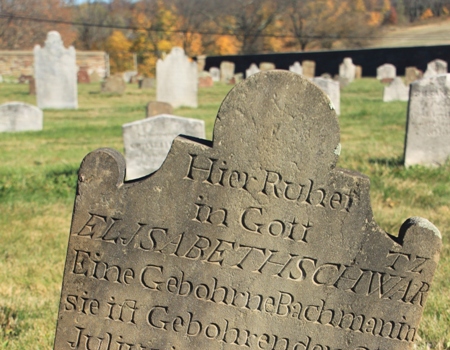New acquisition: Deep Run and Salford gravestone photos
Written by Forrest Moyer on June 14, 2017

In 2016, the MHC received not one, but two collections of digital photos from local Mennonite cemeteries.
The first contains photos of all gravestones in the Deep Run Mennonite East Cemetery in Bedminster Township, Bucks County. The donor, Daryl W. Rice, shot the photos in 2015. He did an excellent job, selecting a time of day when the sun created the best light for reading inscriptions, and getting down to the level of the stones for a good angle.
Most 18th-century Mennonite gravestones did not carry decorative images, but several stones at Deep Run include carvings of crowns and tulips.

A crown for Maria Oberholtzer, 1758; one of the earliest surviving stones in the cemetery. In early years, before marble and granite were widely available, graves were marked with red shale or other local stone.

A crown for Barbara Albart, 1764.

Crown and tulips for Barbara Kolb, 1765, widow of immigrant bishop Henry Kolb.

A tulip for Magdalena Leatherman, 1770s.

A stylized crown (or tulip?) for Henry Loux, 1791.

A stylized tulip for bishop Jacob Gross, 1810. Here we begin to see the finer calligraphic text that appears on 19th-century stones. Some fraktur artists were also stone cutters, creating these beautiful inscriptions.

A finely engraved stone for Elizabeth Bachman Swartz, 1812.
Hier Ruhet
in Gott
ELJSABETH SCHWARTZ
Eine Gebohrne Bachmanin
sie ist Gebohren den 3ten
Julius im Jahr 1732.
und Gestorben den 15ten
May im Jahr 1812.
Alt worden 79 Jahr
10 Monat und 12 Tage
Here rests
in God
Elizabeth Swartz
born a Bachman
She was born the 3rd
of July in the year 1732
and died the 15th
of May in the year 1812.
Age was 79 years
10 months and 12 days

Here lies buried Abraham Landes, 1831 (son of deacon Rudolph Landes).

By the mid-1800s, most people at Deep Run were having their stones inscribed in English. But some members of the pious Gross family continued the tradition of German fraktur inscription. In the case of preacher Christian Gross, who died in 1865, even old-fashioned shale stone was used.

The stone for Christian’s son, preacher John Gross (here called “Rev.”), is the last German gravestone in the Deep Run Cemetery, dated 1903.

Grazing sheep kept the grass down at Deep Run before the rows of old stones were straightened. Photo by Walter Rush, 1949, Mennonite Heritage Center Collection.
Daryl Rice’s photos have been added to the Deep Run listings on Find-a-Grave by MHC volunteer Bud Gross.
The second set of photos is from Kevin W. J. McCoach, who documented the “fieldstones” (early locally-quarried stones) in the Salford Mennonite Cemetery as part of an Eagle Scout project in 2015.
Unlike at Deep Run, there are almost no decorated stones surviving at Salford, with the exception of this tulip for Anna Kratz, 1793, daughter of immigrants Gerhart and Anna Clemens and wife of immigrant Valentine Kratz.


Kevin McCoach photographing the Anna Kratz gravestone.
Kevin also raised funds to install a monument with text by John Ruth, explaining the historical significance of the congregation and cemetery and listing some of the early families buried there. You can read about the project and see all fieldstones with transcriptions in this document compiled by Kevin.

Stone for the monument came from a nearby quarry.

Placing the monument, November 11, 2015.



Folk art painting by Isaac Clarence Kulp of a sexton digging a grave beside the 19th-century Salford Meetinghouse. Mennonite Heritage Center Collection; gift of John & Roma Jacobs Ruth (2008.24.1).

The new meetinghouse built at Salford in 1924 was situated with the pulpit facing the cemetery rather than the road. Puzzling to modern visitors, this arrangement was requested by preacher Henry Clemmer, whose argument was: “I’ve always preached to the whole congregation!” Photo circa 1942. Mennonite Heritage Center Collection.
